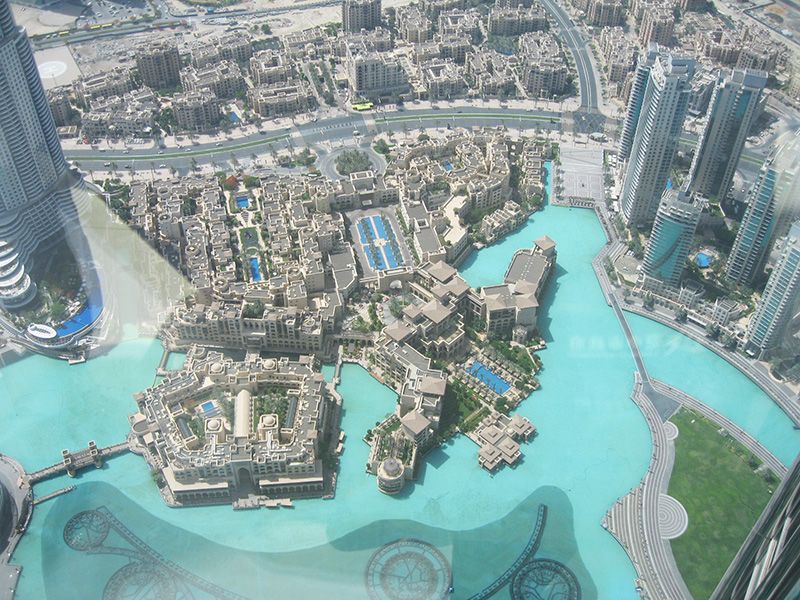
Dubai’s No. 1 Fan of All Things Japanese
Society Culture- English
- 日本語
- 简体字
- 繁體字
- Français
- Español
- العربية
- Русский
One of the United Arab Emirates, tiny Dubai is home to around 2 million people. But in fact, Dubai nationals make up only around one tenth of that total—just 168,000 people. Most of the people you see on the streets were not born here. This is a land of immigrants.
Seeing Dubai: From Two Different Levels
Dubai is a city-state where the future rubs shoulders with the past. The 160-story Burj Khalifa tower in the downtown area is the world’s highest building, at 828 meters. A high-speed elevator whisks visitors to the aptly named “At the Top” observation deck. From this lofty perch, the surrounding skyscrapers look like peas. The city stretches off into the distance, eventually giving way to the endless desert. It looks like a movie set—an encapsulation of the near future in miniature.
It’s also expensive. Entry costs 130 dirhams in advance (approximately US$35). It costs nearly three times more if you simply turn up on the day. Despite the expense, I’d recommend it for the experience of enjoying a bird’s-eye view of the city. The views of this glittering dream of a city, its eyes fixed on the future, are worth it!
After the Burj Khalifa, most tourists board one of the local abra ferries at Dubai Creek. Onboard, Arabs, Indians, Pakistanis, Caucasians, Chinese, and Japanese (that’s me!) are crammed in together like sardines. It’s a vivid reminder of Dubai’s historical importance as a port. The fare is just 1 dirham. Now that’s cheap—too cheap, you might say as you fight your way through the crowds!
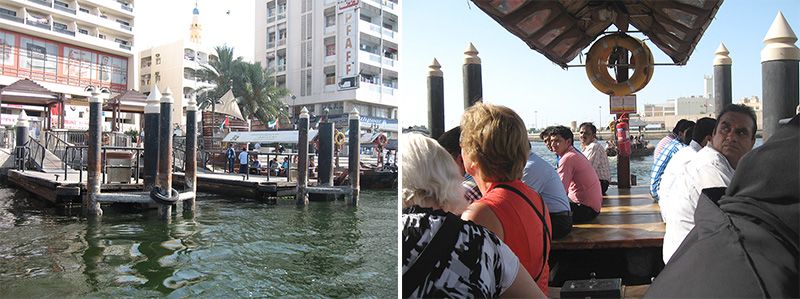 The wharf at Dubai Creek (left). And passengers aboard one of the local “abra” boats.
The wharf at Dubai Creek (left). And passengers aboard one of the local “abra” boats.
Fanned by a gentle breeze, the journey is over in what feels like no time. From the boat, passengers can enjoy the passing scenes of life along the banks and the beguiling sight of the passing abras. The old souk and the Indian parts of town charm visitors with their ageless sights and sounds. As you walk through these old streets and seeing the city from ground level, the futuristic vision of the Burj Khalifa and the modern city around it seems to vanish like a mirage.
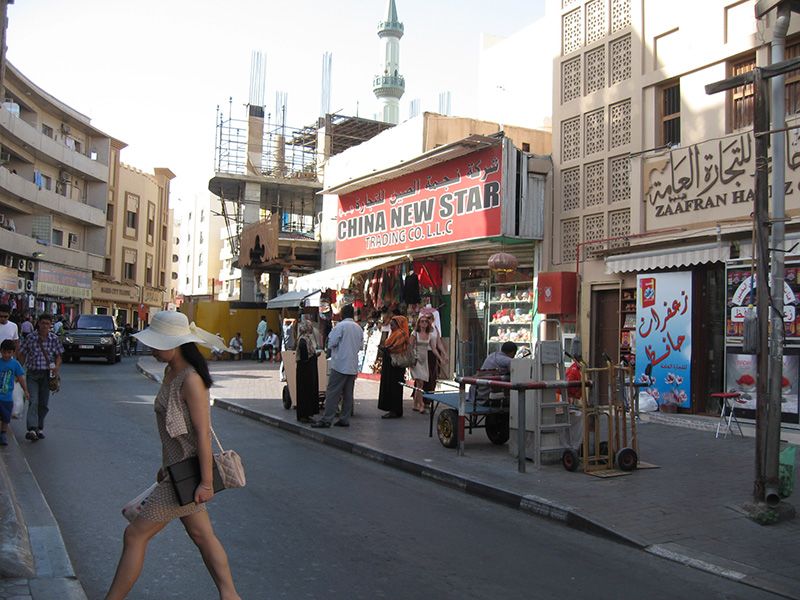 The Indian area of the city still retains much of its old atmosphere.
The Indian area of the city still retains much of its old atmosphere.
According to a book by Takeda Isami called Sekai o ugokasu kaizoku (The Pirates Who Move the World), Dubai is a hidden hub of pirate activity, and a crucial link in the supply chain providing materials to Somalia. They say that dhows of all sizes set sail from Dubai Creek to deliver resources and materials. The income from this trade is part of what keeps the pirates financially afloat.
In Dubai, the present is an intoxicating blur of past and future. It is part of what draws people to the city today, whether they were originally born in the UAE or elsewhere.
Japan is one of the many countries that send business people and travelers to Dubai. According to data compiled in 2011, 225 Japanese companies are operating in the emirate, and 2,267 Japanese people are living here—the largest Japanese community in the Gulf. Even so, business dealings aside this is still a part of the world that feels very far from Japan.
Falling In Love with Manga and Sushi in Dubai
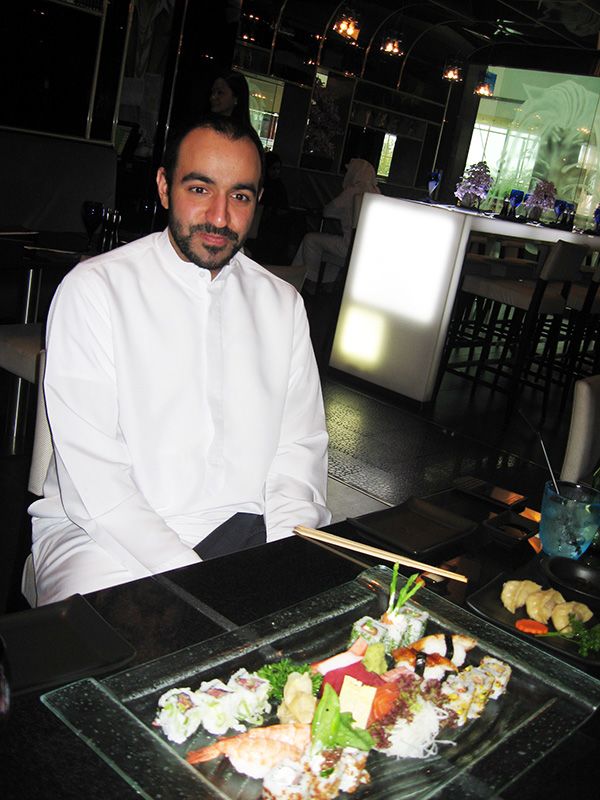 Sultan with a selection of his original sushi creations.
Sultan with a selection of his original sushi creations.
Perhaps that’s part of the reason why I was so thrilled to meet Sultan al Banna. Sultan is the owner of a restaurant in Dubai called Manga Sushi, and he’s a total Japan nut. He claims to “love Japan more than anyone in the world.” Manga Sushi itself seems to be well known among manga and anime fans. But I really think that Sultan himself deserves to be better known in both countries.
Just 30 years old, Sultan is a young entrepreneur who is head of his own company. His first encounter with Japan came through manga. He fell in love with the comics as a 12-year-old, and has been hooked ever since. Doraemon, Captain Tsubasa, Ikkyū-san, Little Heidi, The Rose of Versailles, Dr. Slump and Arale . . . From the latest hits to the classics, he knows them all.
When he was a child, his father often told him to put his comic books down and concentrate on his studies. But he kept on reading. “I just loved them so much. I think manga is wonderful,” he says.
It’s strange but when I talk to Sultan I feel a sense of calm and purity of purpose about him. He’s someone who has mastered his chosen subject.
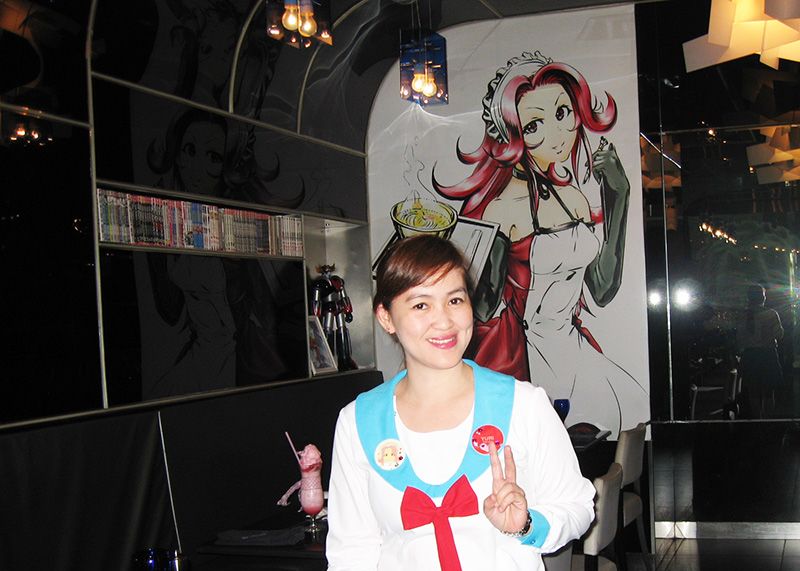 The waitress is a big fan of Tokyo’s Shibuya styles.
The waitress is a big fan of Tokyo’s Shibuya styles.
The restaurant opened five years ago on the second floor of the Beach Park Plaza. It overlooks the Jumeirah Beach on the Arabian Gulf. Sultan’s aim was to provide a spot where people could enjoy his two loves: manga and sushi.
The chic interior of the restaurant is based on black. Drawings and figurines of manga characters decorate the walls. It’s an entrancing site even if you’re not a fan. Naturally there is also a collection of manga books (in English). The restaurant is manga-themed from top to bottom.
An Ideal Ambassador for Manga Culture
The sushi menu also contains plenty of surprises. Alongside the conventional items are others whose names look like some kind of joke: “Godzilla,” “otaku,” “yakuza,” “Dragonball” . . . The names fill your heart with a mixture of excitement and fear as you wait for them to arrive at the table. The “yakuza,” for example, is shrimp tempura, avocado, and lettuce wrapped in smoked salmon. Of course, Sultan is well aware of what “yakuza” means. But he shrugs and says he likes the way the word sounds. “It’s cool,” he says.
There are plenty of other things on the menu besides sushi—even including Hiroshima-style okonomiyaki. Sultan loves to travel. In fact, there seem to be very few places in the world he hasn’t visited. But even so, he says: “Japan is special.” For a Japanese person far from home, his words are music to the ear.
He’s also something of a Japanese history buff. When I ask him what his favorite period is, he answers without hesitation: “The Meiji era [1868–1912].”
He says he finds the period interesting because this was when Japan successfully pushed through its own revolutionary reforms. It’s a fine observation. Maybe Sultan’s interest in manga has inspired him to start his journey toward understanding more profound aspects of the traditional culture.
Long past lunchtime, Arab men and women in the local black abbaya dress are still in the restaurant. Confident and relaxed, Sultan says his dream is to build his business into a place of exchange between Japan and Dubai. Making a profit is apparently not at the top of his list of priorities. How about asking delegating Sultan to act as an ambassador for Japan’s manga culture overseas? Meeting him inspired me with a sense of hope for the future of relations between Japan and the Middle East.
(Originally written in Japanese on September 27, 2013. Photos courtesy of the author.)
